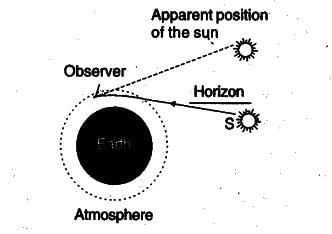Class 10 Exam > Class 10 Tests > Science Class 10 > Test: Atmospheric Refraction - Class 10 MCQ
Test: Atmospheric Refraction - Class 10 MCQ
Test Description
10 Questions MCQ Test Science Class 10 - Test: Atmospheric Refraction
Test: Atmospheric Refraction for Class 10 2024 is part of Science Class 10 preparation. The Test: Atmospheric Refraction questions and answers have been
prepared according to the Class 10 exam syllabus.The Test: Atmospheric Refraction MCQs are made for Class 10 2024 Exam. Find important
definitions, questions, notes, meanings, examples, exercises, MCQs and online tests for Test: Atmospheric Refraction below.
Solutions of Test: Atmospheric Refraction questions in English are available as part of our Science Class 10 for Class 10 & Test: Atmospheric Refraction solutions in
Hindi for Science Class 10 course. Download more important topics, notes, lectures and mock
test series for Class 10 Exam by signing up for free. Attempt Test: Atmospheric Refraction | 10 questions in 10 minutes | Mock test for Class 10 preparation | Free important questions MCQ to study Science Class 10 for Class 10 Exam | Download free PDF with solutions
Test: Atmospheric Refraction - Question 1
Stars appear to be higher in the sky than actually they are because of
Detailed Solution for Test: Atmospheric Refraction - Question 1
Test: Atmospheric Refraction - Question 2
The cold air layers of the atmosphere behave as optically
Detailed Solution for Test: Atmospheric Refraction - Question 2
| 1 Crore+ students have signed up on EduRev. Have you? Download the App |
Test: Atmospheric Refraction - Question 3
How much time from sunrise to sunset is lengthened because of atmospheric refraction ?
Detailed Solution for Test: Atmospheric Refraction - Question 3
Test: Atmospheric Refraction - Question 4
Sun appears to be risen before the actual sun rise because of
Detailed Solution for Test: Atmospheric Refraction - Question 4
Test: Atmospheric Refraction - Question 5
The sun can be seen before the actual sunrise by about
Detailed Solution for Test: Atmospheric Refraction - Question 5
Test: Atmospheric Refraction - Question 6
By how much time is the sunset delayed due to atmospheric refraction ?
Detailed Solution for Test: Atmospheric Refraction - Question 6
Test: Atmospheric Refraction - Question 7
To an observer on Earth the stars appear to twinkle. This is due to
Detailed Solution for Test: Atmospheric Refraction - Question 7
Test: Atmospheric Refraction - Question 8
Why does Sun appear slightly oval shaped at morning and evening ?
Detailed Solution for Test: Atmospheric Refraction - Question 8
Test: Atmospheric Refraction - Question 9
Deviation of light as it passes through the atmosphere due to variation in air density is called
Detailed Solution for Test: Atmospheric Refraction - Question 9
Test: Atmospheric Refraction - Question 10
When light rays from stars enter into earth’s atmosphere, it travels from
Detailed Solution for Test: Atmospheric Refraction - Question 10
|
85 videos|437 docs|75 tests
|
Information about Test: Atmospheric Refraction Page
In this test you can find the Exam questions for Test: Atmospheric Refraction solved & explained in the simplest way possible.
Besides giving Questions and answers for Test: Atmospheric Refraction, EduRev gives you an ample number of Online tests for practice


















